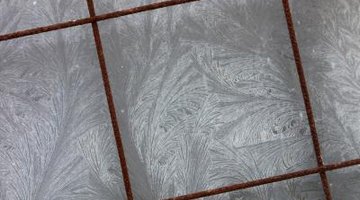How to Get Mortar Off of Tiles
Any tile installation frequently produces mortar spatters or spills onto the face of the tile. Professional tile-setters keep a damp sponge handy to remove any excess mortar before it has a chance to harden; a dry cloth or barely moist rag is best for very porous tile, which might be stained by water containing mortar debris. Once the mortar has dried, however, removing it depends on the type of tile and how old the mortar is.

Step 1
Remove dried mortar from clay tile, also called Mexican or Mediterranean tile, with a wire brush and lots of effort. Clay is very porous, and mortar will penetrate its pores and solidify; the porosity makes clay subject to stains from liquid cleaners. Try flaking off the mortar with a putty knife, but work gently to avoid chipping the tile. Push away from any edges or corners that might break. Use a stiff brush first and switch to a softer version when most of the mortar is removed to avoid scratching the tile.
Step 2
Use commercial liquid cleaners, muriatic acid or ammonia on hard-surfaced ceramic tile; muriatic acid is mild and will work on most cement mortars. Test the liquid on an inconspicuous spot first to ensure that it will not damage the tile's surface. Apply liquids with a stiff bristle brush or sponge and follow the recommendations of any commercial cleaner. Utilize a plastic scraper or putty knife once the mortar has been moistened and loosened. Work carefully and in small segments.
Step 3
Apply a small disc grinder to mortar splatters on ceramic or stone tile; grinding may be most effective on slate and similar stones. Use a fine disc and work very slowly to avoid grinding the surface of the tile. Use a grinder with a dust removal bag to reduce the amount of mortar or stone dust released into the air. Grind only the mortar and avoid contact with the tile's surface as much as possible. Use a wet sponge or brush to remove dust and clean any remaining mortar.
References
Tips
- Wear gloves and a mask when using liquid cleaners or grinders.
- Remove wet mortar as quickly as possible; like all cement products, it gains strength with time and will be most easily removed soon after installation.
Writer Bio
Bob Haring has been a news writer and editor for more than 50 years, mostly with the Associated Press and then as executive editor of the Tulsa, Okla. "World." Since retiring he has written freelance stories and a weekly computer security column. Haring holds a Bachelor of Journalism from the University of Missouri.
Photo Credits
- Hemera Technologies/AbleStock.com/Getty Images
More Articles



